Publisher: Nintendo
Developer: Nintendo
Medium: Switch Card/Digital
Players: 1-4
Online: Yes
ESRB: E
If the games industry ever found itself with a shortage of wackiness, they can always turn to Nintendo to serve up something crazy enough that it just might work. Their latest concept is the experimental motion-control fighter, ARMS, where players control fighters with springy limbs in arena-style combat. It’s Nintendo’s most recent IP, and hoping to be the Switch’s first big, exclusive splash.
If the art direction, screenshots, or any of the numerous gameplay videos online haven’t tipped you off, the game’s visuals reflect an athletic intensity which isn’t far from the truth. There’s some Nintendo charm in here, but following Splatoon’s departure from cute toward competitive, the gloves are off in the world of ARMS. Well, they’re still on, but players will notice the sense of energy almost immediately. This isn’t going off on a tangent either, since ARMS demands your focus and its presentation does a great job of keeping players amped up over the course of different matches and modes.
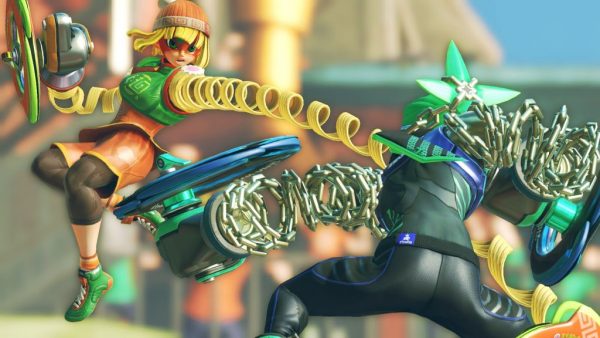
There’s also not much story here, and it isn’t worth discussing unless you’re really into the lore. The game’s Grand Prix campaign doesn’t give you much to work with, and in line with the focused, almost barebones content that the game has, the plot keeps things simple and straight to the point. You’re going to compete against other fighters, now fight!
Or as the announcer says at match starts, “Arms!”
Since Grand Prix has the biggest font and is the campaign mode, you might think this is where the meat of the game is. You’d be wrong. It’s about as substantial as playing through the “Arcade” mode of any 2D fighter, with 10 rounds on offer, about 8 of which are one-on-one against a computer AI, and the others being a variety game like target smashing or dunking hoops with your opponent. That’s right, using the grab move and literally dunking your opponent in a basketball hoop.
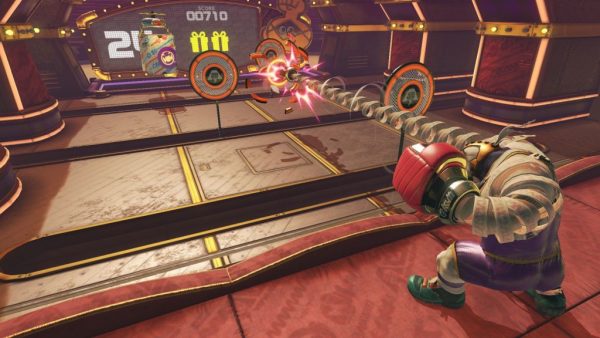
This mode is also the least interesting, and most frustrating. I hopped in at Rank 4 difficulty, right about in the middle of the adjustable scale, and found fights to be really frustrating about halfway in. While it’s always an option to play at a difficulty that suits you, players must complete Grand Prix on Rank 4 or higher in order to play Ranked matches online. If you can’t swing it, you’re probably better off in the wading pool.
This leads in to my main issue with ARMS, which while there aren’t many problems (or even any dealbreakers), it’s a significant one. The problem being that the game’s motion controls aren’t good enough to function effectively against skilled competition or AI. This stems partly from the control scheme, game design, and I’d also guess the limitations of hardware as well.
Firstly, there’s kind of a steep learning curve to ARMS. Its basic gameplay is simple and easy to pick up and play with motion controls. Holding both switch controllers in a boxing stance, you control character movement by tilting the joy-con’s simultaneously in any direction. Punching is simply punching outward with your hands, and tilting the joy-cons will curve your punch left or right. Grabbing is done by reaching out with both hands at the same time. Dashing, jumping, and activating your super attack are mapped to shoulder buttons. For the most part, it feels like it should, and getting used to using your dash and jump are probably the biggest things holding you back.
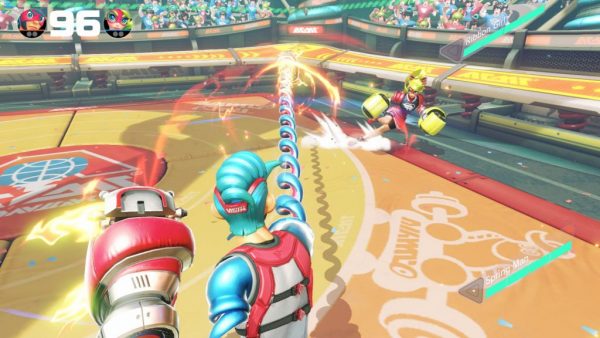
When it comes to higher levels of play, however, things get messy. I’d attribute this partly to the decision of mapping movement to the tilting of both joy-cons. If you’re punching with your right arm, then throw a left, all the while hoping to keep moving, there’s a quick threshold of input that is met. The same can be said for grabbing and blocking, both of which are moves using both controllers at the same time. Sometimes, the game will interpret a grab as two separate punches, or a block as a grab if you’re uncoordinated like me, or my favorite, when the controls interpret a blocking stance as doing nothing except walking slightly back and forth, open to attack.
That said, with the amount of control input relying on specific gestures, there’s a quick and steep learning curve that could take players hours to finally feel comfortable with. Even when you do, the motion controls don’t have the precision or reliability needed to effectively fight difficult battles. By the last few rounds of Grand Prix, I had migrated to the traditional control scheme, which takes less time to adjust to and allows for faster and more precise reaction and control over your character.
I wouldn’t completely discount the motion controls, though. I found them to be the most engaging way to play, and my muscles were completely sore any day after using them. They honestly give a good workout, and it’s fun to get off the couch and get involved with a fighting game like this. It sounds like the same stuff you’d hear back when the Wii came out, but there’s something really satisfying about physically landing a critical hit.
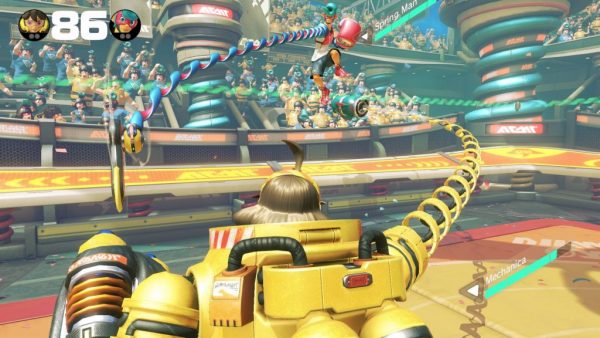
Wrapping up the game’s unique controls, they’re good fun, but far from perfect. They’re best suited for less serious engagements, such as playing against friends locally or going online. In no surprise to anyone, the ARMS experience really shines when you play against other people.
Serving up a variety of modes which draw from both fighting and non-combative gameplay, such as volleyball and other recreational scenarios, ARMS allows players to mess around with the mechanics outside of taking down health meters. It’s really more of a party game than precision arcade fighter, and playing with other people compliments an already-interactive experience.
The party game aspect is even more apparent when considering how much ARMS focuses on unlocking new arms for each character. It’s a lot of fun to mix and match different fighting equipment with the already eclectic cast, but if ARMS has replay value, a large part is rooted in the appeal of unlocking every available asset.

I also found online play to be just as enjoyable as playing locally. In my experience during the test punch and retail game, online play was reliable and generally trouble-free. Some people may not care for how the game handles matchmaking outside of Ranked play, where the modes and players are automatically assigned by the game, but I preferred this randomized style as it felt like one less thing to think about between the physicality of each match. If you really want to mark your territory, there’s an option to create a lobby with friends and customize your settings.
This is a review based on the content available at the launch of ARMS, but Nintendo promises free updates with new content including stages, characters, and arms to come. What’s less likely to change between the time of this writing and months down the road is the core gameplay of ARMS. The motion controls bring out its greatest faults, with some of the blame landing on the game’s high-energy presentation suggesting a different mindset than you’ll find with skilled opponents.
ARMS biggest issue isn’t even inherent in the motion-based controls it proudly showcases, but in the fact that the game so thoroughly commits to that being the primary method of playing that it compromises an actual frenetic boxing match. In many ways, this is a version of Wii Sports boxing that still struggles to represent its inspiration. The essential ideas are there, since high-level play involves waiting for your opponent to strike, leaving themselves vulnerable while their arm stretches across the stage, but this abstract form of boxing turns out to be a lot less fun to play than you’d hope. Especially against higher difficulty AI. Even with the traditional controls, it feels like a game of wait-and-see due to stiff character movement and enough of a slowed down version of fisticuffs that combat feels tedious right at the level of complexity where depth should reward skilled players.
For these reasons, the gameplay finds itself right where it stands: between Wii Sports boxing and Virtua Fighter with elastic limbs. For what it’s worth, I realize this review is a lot of criticism with little praise. In all fairness, I’d just as soon stand up for ARMS as I’ve come down on its issues. In this case, it just happens to be that the things ARMS struggles with took more explanation than expected in an already lengthy review.
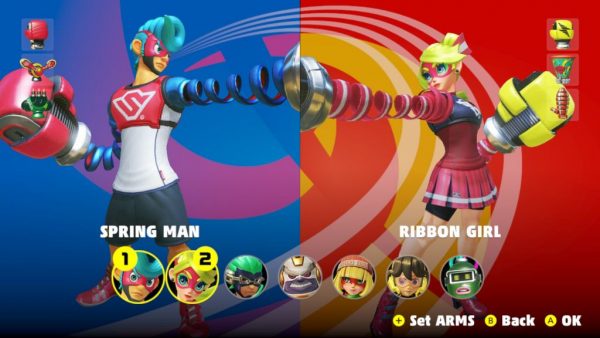
That said, if players hop into ARMS without grand expectations of it being the next best fighter, there’s a lot to love here. It can still be the next best Switch party fighter. It’d be a great next best Switch party fighter! That still doesn’t free it up from having some imperfections, so it’s recommended not to take the game’s intensity too seriously. This is something to break out when you have company over or want to burn energy with some online play. It’s an experimental game, after all, and experiments don’t always wind up how you’d expect.
Where Splatoon’s motion controls elevated the game’s precision as a shooter, the motion-based fighting in ARMS reveals that Nintendo doggedly pursued one core idea and built the rest around that foundation, whether or not it was an improvement on a pre-existing genre. ARMS is nothing of the sort. Instead, it’s simply different; sometimes with frustrating compromise, and other times a refreshingly unique take on fighting games. Surprisingly, there are few surprises about how the final product turned out, so if you think this game is for you, it probably is. If not, it’s worth a few rounds at a friend’s place or a rental — if only to see what the latest idea Nintendo thought was crazy enough that it might work, dedicated to seeing through, and delivered as a highly polished product.

